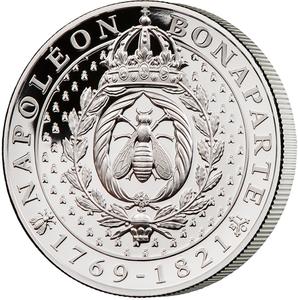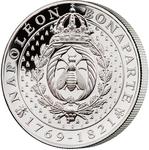Saint Helena is a small island in the South Atlantic Ocean which is part of the British overseas territory of Saint Helena, Ascension and Tristan da Cunha. The currency of the island is the Saint Helena pound, fixed at parity with the pound sterling. The island has authorised some private mints to issue coins under its jurisdiction, which come in a variety of sizes - including in the very large silver kilogram (1 kg silver) format, denominated variously as £1, £5 or £50.
This silver kilogram coin denominated as £1 is part of a commemorative range marking the 200th Anniversary since the death of Napoleon Bonaparte.
The Mint says about it:
Napoleon Bonaparte built an Empire across Europe before defeat at Waterloo in 1815 saw him exiled to St Helena, a peaceful island owned at the time by the East India Company. He lived out his final years on St Helena until his death in 1821. To mark the 200th Anniversary of Napoleon’s death, we pay tribute to his time on St Helena and celebrate the icon that came to symbolise his Empire; the humble but powerful bee.
When Napoleon crowned himself Emperor of France in 1804, he was keen to replace the remnants of the fallen Bourbon dynasty, including their emblem, the Fleur du Lys. He learned about the discovery of the tomb of Childeric I, king of the Merovingian Franks, and the 300 tiny gold bees that were found buried alongside his remains as a symbol of immortality.The bee is symbolic of harmony, working together for a bigger cause. They are pollinators, bringing fertility, and producers of honey, offering the gift of sweetness. Napoleon recognised these important characteristics and used golden bees across his Empire; they are on his Coat Arms, they appeared on metalwork, furniture and ceramics, the motifs stitched into his coronation robe and the patterns on the wallpaper and carpets of his palaces.
After Napoleon’s final defeat at the Battle of Waterloo in 1815, he was exiled to St Helena, a peaceful island owned by the East India Company. He lived on the island in Longwood House until his death in 1821, when he was buried under a willow tree in the garden, a simple gravestone marking the spot. Napoleon’s remains were eventually returned to France in 1840, a triumphant journey that saw his coffin transported by a magnificent horse drawn cortege upon which, according to newspaper reports, “on both sides hung two velvet imperial mantles, sprinkled with bees". Inspired by ancient French history; symbols of the industry and harmony of a brave new Empire; decorations upon the cortege of a returning hero. Napoleon’s Bees were, and remain, a powerful icon of a remarkable life and legend. |
| Obverse | |
|---|

The obverse of the coin depicts the crowned old bust of Queen Elizabeth II facing right, wearing the Royal Diamond Diadem crown worn for her Coronation (effigy known as the "Fifth Portrait" worldwide but "Sixth Portrait" in Australia, where the Queen's portrait by Vladimir Gottwald was fifth).
The Queen also wears the Coronation Necklace; originally made for Queen Victoria in 1858, it was also worn at the coronations (as Queen's Consort) of Queen Alexandra in 1902, Queen Mary in 1911 and Queen Elizabeth (the Queen mother) in 1937.
Unlike on British coinage, the effigy is "uncouped" (includes the Queen's shoulders). In small letters on the left, the artist's initials JC (for Jody Clark).
Running continuously around the rim is the monarch's legend, the date of issue and the face value: ELIZABETH II · D · G · REGINA · F · D · ST. HELENA · 1 POUND · 2021 ·. Translated from Latin: Elizabeth the Second, by the Grace of God, Queen, Defender of the Faith, Saint Helena.
|
|
| Reverse | |
|---|

The reverse design shows a bee, a symbol of industry and harmony that connected Napoleon Bonaparte’s new Empire to the kings of ancient French history, surrounded by a crowned laurel wreath (symbol of victory) held at the bottom by an orb with a cross on top. In the background, a swarm of bees picked out in proof frosting. The crown on top is the one used at Napoleon’s coronation in 1804, an interpretation of the ancient crown of Charlemagne which was lost during the French Revolution.
Around above, divided by the crown, the inscription NAPOLÉON BONAPARTE.
Around below, the dates of Napoleon's life 1769 - 1821, followed by the EIC mint mark of the East India Company - the letters are separated by arrows radiating from the centre around which they are situated. A single bee forms a punctuation point in the coin’s outer circle, positioned opposite the East India Company mint mark. |
|




 Search for Saint Helena: Silver Kilo 2021 Napoleon - Bees on eBay
Search for Saint Helena: Silver Kilo 2021 Napoleon - Bees on eBay 

